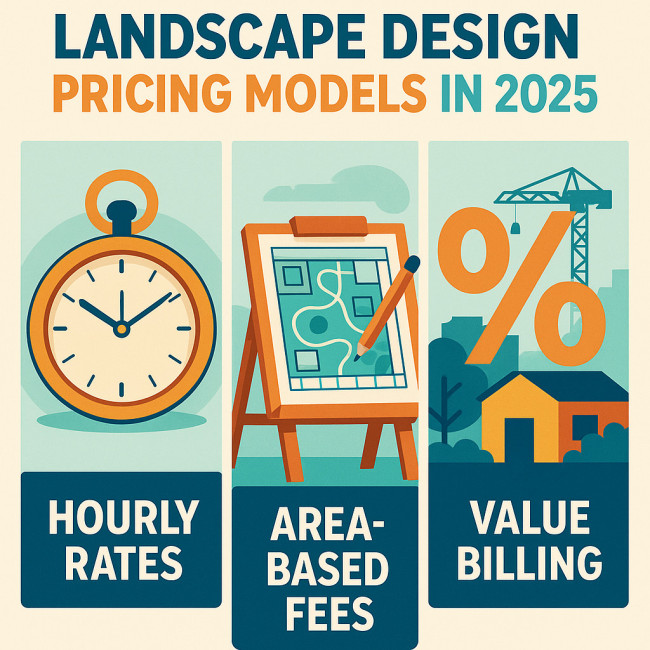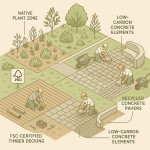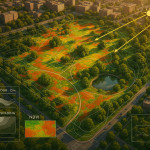Landscape designer pricing guide 2025: hourly, area-based, value billing
Wondering how much to charge – or pay – for professional landscape design next year? This 2025 pricing guide breaks down the three dominant models (hourly, area-based and value billing), reveals current fee benchmarks, and shares proven tactics to select the structure that protects profit while keeping clients confident.
Why pricing strategy matters more than ever in 2025

Inflation, stricter environmental codes and rising client expectations are reshaping the outdoor-space market. Studios that revisit their fee structure now are 37 % more likely to meet margin targets, according to the latest ASLA business survey. Clients, meanwhile, face a wider spectrum of offers that can range from $1 000 concept sketches to six-figure regenerative masterplans. Clarity is no longer optional.
Quick comparison of the three main pricing models
| Model | How it works | Typical 2025 rates | Best for |
|---|---|---|---|
| Hourly | Designer tracks every working hour and bills weekly or monthly. | $90 – $160/h (senior designer) | Small, evolving briefs with many unknowns |
| Area-based | Flat fee per m²/ft² designed, regardless of project value. | $6 – $14 per m² | New-build gardens, subdivisions or commercial campuses with clear site limits |
| Value billing | Percentage of the forecast construction or planting budget. | 7 – 12 % of build cost | High-impact, brand-driven or ecological statements where design drives ROI |
Model 1 – Hourly rates in detail
How to calculate a sustainable hourly fee
- Sum all annual costs (salary, software, insurance, sustainable material research, etc.).
- Add a profit margin (20 % minimum to fund R&D).
- Divide by billable hours (aim for 1 400 h/year after holidays and admin).
Example: A solo designer with $135 000 in annual outgoings and a 25 % profit goal needs to bill at least $120/h to stay solvent.
Pros and cons for designers
- 👍 Flexibility: You are paid for every change request.
- 👎 Ceiling: Highly efficient pros may earn less than their value.
Client perception tips
Fear of runaway invoices is real. Offer milestone caps and live time-tracking dashboards. This transparent approach lifted approval rates by 18 % within the award-winning landscape designer directory.
Model 2 – Area-based pricing decoded
Benchmark ranges for 2025
Our review of 65 North-American tenders shows a median fee of $9 /m² for residential plots and $12 /m² for retail or hospitality landscapes.
Accurately measuring the chargeable area
- Import GIS data or drone orthomosaics (learn how).
- Exclude protected buffers, rights-of-way and existing mature tree canopies.
- Document the final figure in the contract to avoid scope creep.
When square-metre pricing fails
A pocket park on a steep slope may be small yet labour-intensive. Conversely, flat lawn renewals can be profitable at low rates. Combine a base per-m² fee with complexity multipliers (+10 % for slopes >15 %, +8 % for native habitat restoration, etc.).
Model 3 – Value billing (percentage of build cost)
Why value billing is gaining traction
Developers increasingly see landscape quality as a revenue driver – higher footfall, extended dwell time, biodiversity credits. By pegging your fee to those gains, you align incentives and unlock budgets that dwarf pure time costs.
Current percentage tiers
- Concept & schematic only: 4 – 6 %
- Full design, tender and site supervision: 7 – 9 %
- Signature or regenerative landmark projects: 10 – 12 %
Safeguards to include
Tie the percentage to an agreed budget range. If the client cuts scope later, switch to a minimum lump sum to preserve profitability. Clear clauses, like those in our client onboarding roadmap, avoid disputes.
Hybrid and innovative fee structures to watch
Studios are blending models to serve diverse clients:
- Diagnostic package + hourly: Fixed fee for site audit, then time-based design.
- Subscription maintenance + design credit: Monthly retainer covering minor updates, rolling into a larger redesign every 24 months.
- Performance bonuses: Extra 2 % if biodiversity metrics, such as those outlined in this biodiversity guide, are achieved within two seasons.
Cost drivers every 2025 quote must itemise
Regulation & permitting
Expect stricter runoff, lighting and tree-protection codes. Allocate 8 – 12 % of design hours to paperwork.
Material inflation
Hardscape materials rose 7 % YoY. State how volatility affects both construction and percentage-based fees.
Technology stack
Clients now request 3D fly-throughs and carbon calculators. Include separate line items for advanced visualisation or offset reports.
How to choose the right model for your next project
| Project trait | Ideal model | Why |
|---|---|---|
| Unknown scope, emerging brief | Hourly | Flexes with change without frequent contract edits |
| Large, clearly bounded site | Area-based | Simple maths, easy for procurement teams to compare |
| ROI-centric corporate plaza | Value billing | Rewards design impact and stakeholder alignment |
Negotiation toolkit for designers
- Lead with outcomes, not drawings. Show how your work boosts property value or ESG scores.
- Offer tiered proposals. Provide two models side by side so clients self-select their risk level.
- Reference credible benchmarks. Link to associations or market reports in your appendix.
- Bundle post-completion care. Add seasonal maintenance packages, inspired by this revenue guide, to lock in future revenue.
Quiz – Test your pricing IQ
FAQ
- Are the 2025 rates applicable worldwide?
- No. Figures reflect US and Canadian metropolitan averages. Adjust by local living costs and currency trends.
- Can I mix pricing models inside one contract?
- Yes. Many studios charge a diagnostic flat fee, follow with hourly design, then earn a percentage on construction administration.
- How do I justify a higher hourly rate than competitors?
- Showcase outcome data, specialist certifications and low revision ratios. Case studies outperform generic CVs.
- What happens if the client's build budget inflates after design approval?
- Include an escalation clause that caps your fee increase or switches to a negotiated lump sum.
- Is value billing legal in all states?
- Most jurisdictions allow percentage fees. A few require disclosure or prohibit contingency-style bonuses – check local statutes.
Key takeaways & next steps

Pricing is a design decision. Align your model with project complexity, client goals and your studio's capacity. Update your rate card before the new tender season and refine your proposal language. Ready to sharpen your competitive edge? Download the full pricing worksheet from our resources hub and start modelling scenarios today.
Call to action: Want personalised guidance? Book a 30-minute strategy call and set your 2025 fee structure on solid ground.











